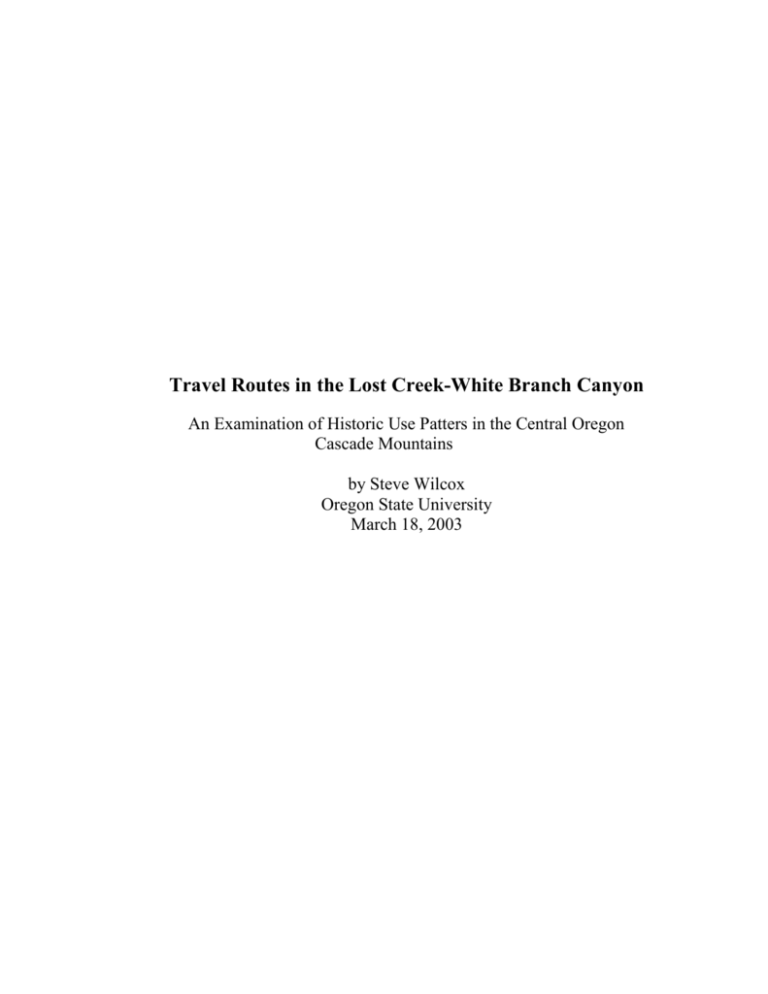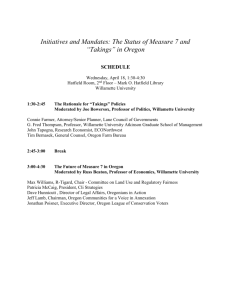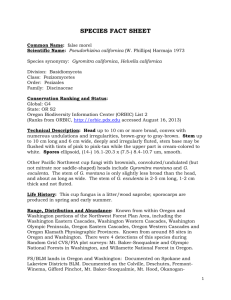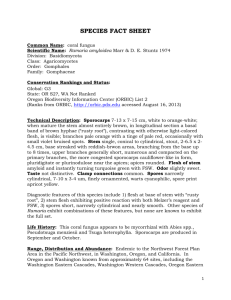Travel Routes in the Lost Creek
advertisement

Travel Routes in the Lost Creek-White Branch Canyon An Examination of Historic Use Patters in the Central Oregon Cascade Mountains by Steve Wilcox Oregon State University March 18, 2003 Wilcox - 2 Introduction The Cascade Mountains of Oregon have existed as a travel barrier between the Basin and Range land of the Inter-Mountain West, and the Willamette Valley since before humans occupied North America. When Anglo-Americans arrived on the scene one of their first concerns was to locate a suitable East-West crossing of the mountains. In addition to adding weeks of travel to a cross-continental trip, the Missouri-SnakeColumbia Rivers route was arduous and dangerous. I have attempted to reconstruct the influence of the physical landscape upon human travel through one such crossing, the Lost Creek-White Branch Canyon of the present day McKenzie Pass. As this is one of several routes across the mountains, I will also examine the similarities and differences of several alternative routes. Description The Lost Creek-White Branch Canyon is located in the Central Cascade Mountains of Oregon in the northeast corner of Lane County. The nearest towns are McKenzie Bridge to the west and Sisters to the East. The elevation (above Mean Sea Level) ranges from 496 meters at the confluence of Lost Creek with McKenzie River, to 3,074 meters at the summit of North Sister. Lost Creek drains an area of approximately 19,900 hectares and has a western aspect (See Plate I). The Cascade Mountains form a barrier to moist Maritime air masses that are flowing inland from the Pacific Ocean. The orographic effect of this moist air rising over the mountains results in heavy snowpack Wilcox - 3 and excellent growing conditions for coniferous trees. Annual rainfall ranges from 135 cm. in the lower canyon to 270 cm. at the peaks (National Atlas). The canyon straddles two physiographic provinces, the Western Cascades and High Cascades. The Western Cascades is characterized by a series of highly dissected main ridge crests composed of Oligocene and Miocene basalts, andesites, and pyroclastics. Elevations rarely exceed 1,500 meters. Glacial deposits are scattered in stream channels making the extent of glaciation difficult to determine. Soils formed from pyroclastic materials are poorly drained and subject to mass wasting while those formed from basalt and andesite are deeper and stable. The Western Cascades Province is associated with the Tsuga heterophylla plant community. Primary components of this community are: Western Hemlock (Tsuga heterophylla), Douglas Fir (Pseudotsuga menzeisii), and Western Red Cedar (Thuja plicata). Less common are: Western White Pine (Pinus monticola), Incense Cedar (Libocedrus decurrens), Sugar Pine (Pinus lambertiana), Ponderosa Pine (Pinus ponderosa), Pacific Silver Fir (Abies amabilis), Pacific Yew (Taxis brevifola). Hardwoods are uncommon except on disturbed or specialized habitats (Franklin and Dryness 1973). The High Cascades are much younger, having been extruded from volcanic vents in the late Pliocene and Pleistocene. Some flows are very recent, within the last millennia (USGSa) (See Plate II). Monitoring during the last decade has revealed a magmatic uplift of about 20cm centered about 10 km west of South Sister at the head of the Horse creek, the next drainage south of White Branch (USGSb). The province consists of a high plain of 1,500-1,800 meters elevation dotted with volcanic peaks and Wilcox - 4 deep glaciated channels. Pleistocene glaciation was extensive and the area retains the largest concentration of remnant glaciers in Oregon with 17 named glaciers covering 7.5 km2. During the Neoglacial period (5,000 years ago to present), glacial advance reached its maximum extent in 1850-1860, just prior to Anglo-American road building activity (O'Conner et.al. 2001) (See Plate III). The High Cascades Province is associated with the Abies amabilis and Tsuga mertensiana plant communities. Primary components of this community are: Mountain Hemlock (Tsuga mertensiana), Pacific Silver Fir (Abies amabilis), Nobel Fir (Abies procera), Sub-Alpine Fir (Abies lasiocarpa), Grand Fir (Abies grandis), Englemann Spruce (Picea engelmannii), Lodgepole Pine (Pinus contorta), and Western Larch (Larix occidentalis) (Franklin and Dryness 1973). There was also a long tongue of ice flowing down the canyon to near the confluence with McKenzie River (Loy et.al. 2001). Soils are poorly weathered volcanic ejecta and glacial deposits (Franklin and Dryness 1973). The region is composed of two types of volcanic features; composite volcanoes and mafic features such as cinder cones and shield volcanoes (Scott et.al. 2001). The lower valley is approximately 700 meters wide and bounded by 400 meter steep lava cliffs. The valley floor is gently sloping up to Alder Springs. Above Alder Springs, the canyon floor rises steeply up “Deadhorse Grade”. This stretch of highway gains about 400 meters elevation over about 5 kilometers of hairpin turns. Above the Grade, the road again levels out and gradually climbs to the summit (USGSc, USGSd). Wilcox - 5 Methods A variety of sources were consulted for this work. Sources consulted included a library search, Internet search, historical topographic and cadastral survey maps, computerized data sets and images, and personal photographs. The library and Internet searches yielded textual accounts of Native-American and Pioneer activities. GLO (Government Land Office) Cadastral Survey maps from 1870-1890 were located but were not especially helpful for determining road locations. As private or corporate interests had claimed little of the area, the survey had not been extensive. Road and trail locations were highly generalized. Township and Range lines were projected on paper but not laid out on the ground (Metsker 1924). Due to formal Wilderness designation, much of this work is yet to be completed. These maps were useful in determining which name to apply to several existing routes as well as to indicate that early route finders were not constrained by boundaries and legal descriptions to the degree modern engineers are. The surveyors often made notes on the vegetation present but were not always trained in recognizing tree species or in the value of using consistent terminology in descriptions. They did make distinction between timberlands and grazing lands. USGS (United States Geological Survey) 15’ Series Topographic maps published c. 1955 were very useful in determining the locations of trails that are not in current use. These maps were digitally scanned and geo-rectified into a GIS (Geographic Information System). Cultural features such as roads, trails, and fire lookouts could then be digitized and layered over modern imagery to detect change over time. Wilcox - 6 CFF files (Cartographic Feature Files) were used in the GIS to determine modern road and trail networks. (USDAa) A DEM (Digital Elevation Model) of 30-meter grid spacing was used to determine topographic features for analysis and display (USDAa). A dataset of historic Fire Lookout locations was digitized using tabular data to compare items such as: Feature Name, Elevation, Township, Range, and Section, to points on a modern digital topographic map. The DEM was useful in calculating what parts of the landscape would be visible from the lookout stations (Kresek 1998). Other computerized datasets included isohyetal (rainfall) regimes, stream networks, lava flows, and glacial maximum extents, and USDA Forest Service vegetation cover models. Photographs of historic periods were compared to the author’s personal collection. Data was processed with a Geographic Information System using ArcGIS 8.1 software from Environmental Systems Resources Institute. Images were processed using Adobe Photoshop 6.0 Native American Travel The earliest known human travel route was the Klamath-Molala Trade Route. This trail provided north-south communication between the Great Basin cultural groups of the Klamath and Paiute with the Columbia Basin trade centers of the Chinook. The trail started in the Klamath Basin, traversed north along the east flank of the Cascades and crossed west to the Clackamas river system somewhere south of Mt. Hood. This route had the advantage of avoiding the deeper snow, denser vegetation, and highly Wilcox - 7 dissected topography of the Western Cascades. Present day Highway 97 is heavily traveled today for the same reasons, with the added bonus of connecting to Interstate 80 and avoiding the dangerous descent of the Columbia River. An examination of maps showing Oregon tribal lands in 1840-1850, indicated the route would also unite the Northern and Southern branches of the Molalla without trespass through lands controlled by the Calapuya Nation (granderhonde.org). Mining One volcanic feature that influenced early human travel is Obsidian Cliffs. This 70-90 meter high, 2.4 Km., long obsidian-rhyolite flow originated near the western base of North Sister about 95,000 years ago (Hill 1992). The flow is a source of Paleo-Indian and Archaic Period tool manufacturing material that has been traded throughout the state. This source was widely used during post-glacial period by both the Kalapooya and Molala Native American groups. Native Americans have been mining tool-making material at Obsidian Cliffs for the last 8,000-10,000 years (granderhonde.org) In 1999, wildfire suppression activities 30 Km northwest unearthed the Paul’s Fire Cache, a cache of 30 Archaic period biface lithics (USGSe) Chemical analysis of the Paul’s Fire Cache material has traced about a third of the lithics to Obsidian Cliffs (Jackson et.al. 1992). The area was also used seasonally by Native American groups for other huntergathering activities such hunting large game, picking huckleberries (Vaccinium spp.), and gather beargrass (Xerophyllum tenax) for basketmaking. The Rock Mesa, an area of volcanic tephra (pumice) was considered for mining during the decades of the 1960s and 1970s. The Wilderness Act of 1964 allowed mining Wilcox - 8 and the attendant road construction on existing claims. Due to the cost of construction, short operating season, and public opposition this road has never been constructed. Pioneer Roads In 1862 Felix Scott Jr. led a party herding 700 (or 900, McLean 1963) head of cattle, and nine wagons up the McKenzie Valley and across Central Oregon to newly opened mining districts in Idaho. From his farm at the mouth of the Mohawk River, the route traveled up the McKenzie valley to Salt Springs (present Belknap Hot Springs). At this point the party turned east up Scott Creek, across the Lake Valley and around the head of the White Branch valley to the base of Middle Sister. This trek was made arduous by dense stands of timber and steep slopes. Some slopes required 26 oxen to pull one wagon. From here they turned north, skirting the lava fields and crossing the cascade crest south of Black Crater. This section is part of the present day Pacific Crest Trail. After taking 6 months to cross lava near the pass, the party was forced to over-winter just east of the Cascade Crest for 4 months. Based upon the present vegetation in this area I would not believe that large a party of livestock could survive here today. Two years later he made another trip with his brother Marion and 400 head of cattle. On both trips the party encountered hostile Indians. Scott’s father had written about the reasons for Anglo/Indian hostilities two decades earlier : “The Indians whose lands we have violently taken possession of have become restless and impatient. We have told them that the ‘Boston___” (sic) would come and pay them for their lands. They with great patience have waited from year to year till their patience has become exhausted.” (Scott, F. 1847) Wilcox - 9 John Templeton Craig, as one of Scott’s first party, was dissatisfied with the route. He spent the next summer locating a route that would avoid the steepest parts of Scott’s trail and cross the crest at a lower elevation. This was not an easy road to construct, Craig told the works “only three quarters of a mile of lava to pulverize” (McLean 1963). Some sections of this road still exist. (Figure 1, photo by author). Figure 1. In September of 1865, George Millican, William Miller, J.M. Dick and James Gray filled articles of incorporation for the McKenzie Valley and Deschutes Wagon Road Company. Craig was deeply involved in this project, yet it is unclear whether he was contracted by Millican’s group, or volunteered. The company was to construct a road “From Robert Millican’s Place by way of the valley of the McKenzie and the most feasible Pass of the Cascade mountains, north of the Three Sisters to the crossing of the Deschutes above the mouth of the Crooked River” (McLean 1963). This type of route description indicates that early engineers tried to construct roads to fit the terrain, as opposed to the modern practice of fitting the terrain to the route. Wilcox - 10 Craig constructed the first bridge over the upper McKenzie River from felled trees. The bridge was pronounced fit for use on June 26, 1869. By 1871, the road was in use. The road shortened the Oregon Trail to Willamette Valley trek by 200 miles compared to the Barlow Trail route. (McLean 1963) (See Plate VI). In 1875 Craig obtained a contract to carry mail to Camp Polk. During the winter of 1877, Craig died in a cabin near the summit, apparently of hypothermia. (Anon a) As late as 1985, one map showed no roads in the area (Preston 1985) (Figure 2.) Figure 2. Wilcox - 11 Other Roads Travel was a dangerous undertaking for many of the emigrants on the Oregon Trail. They felt there was little help from the Federal Government. Felix Scott, Sr. said “I wish to God those members of congress who oppose the bill would have to cross these mountains as poorly outfitted as the emigrants generally are. They would learn by hardships and privations to feel for others” (Scott 1847). One of the most dangerous portions of the Oregon Trail was the section through the Columbia Gorge. During the last Ice Age a series of torrential floods emptied Glacial Lake Missoula. As a column of water 500-1,000 deep was forced through the Columbia Gorge it scoured all topsoil and gravel from the river channel and banks (Alt, 2001). The effect of this scouring was to leave a rough lava riverbank bounded by steep cliffs, making the construction of a wagon trail unfeasible. The gradient of the streambed combined with the removal of all light material left a river full of rapids. This forced the emigrants to float the rapids of the river in rafts. The rafts were often poorly constructed and grossly overloaded in addition to being manned by persons not skilled in river navigation. When Sam Barlow constructed the Barlow Road south of Mt. Hood in 1945, he found many willing to pay the toll in order to use a safer route. However, safer did not mean easier. The search continued for a better route. In 1853 the Lane County commissioners contracted construction of the Free Emigrant Road across the Cascades along the south flank of Diamond Peak and down the Middle Fork of the Willamette River to Eugene City. This route was difficult to travel Wilcox - 12 with wagons and soon lost favor with travelers. By 1864 the difficulty of the Free Emigrant Road combined with the need of the Army to move troops rapidly spurred construction of the Oregon Central Military Road. This road closely followed the Free Emigrant Road and was widened to make passage of wagons feasible (Beckham 1981). Political Administration The first permanent Anglo-American settlers arrived in the Southern Willamette Valley in 1846 (Beckham 1891). At that time the Upper McKenzie was controlled by the Calapuya Indians. Within two decades, white travelers were using Lost Creek Canyon to move livestock and mail to the grasslands of Central Oregon and the mines of Idaho. The Cascade Forest Reserve was created in September, 1893 by proclamation of President Grover Cleveland. The Reserve stretched from the Columbia River nearly to the California border. The Sundry Civil Appropriations Act of June 1897 (Organic Act) provided funds for management and mandated goals. In February, 1905 management of the Reserves was transferred from the Department of Interior to the Department of Agriculture with Gifford Pinchot as the first Chief Ranger of the Forest Service. In 1908, the Cascade Forest Reserve was divided into the Oregon National Forest, Cascade National Forest, Umpqua National Forest, and the Crater National Forest. In 1911, the Santiam National Forest was created from parts of the Oregon and Cascade National Forests. In 1933, the Santiam and Cascade National Forests were combined to form the Willamette National Forest, where the authority remains today (USDAb). Wilcox - 13 Modern Highways Construction of the modern McKenzie Highway began about 1920, and was finished September 21,1925. When originally constructed this highway was given the number 126, later the Clear Lake Cut-Off to Santiam Highway was named 126 and the McKenzie Highway was designated 242. This highway closely followed the route of the Salt Springs and Deschutes Wagon Road, (also known as the McKenzie Valley and Deschutes Wagon Road) with some adjustments made possible by the use of bulldozers and dynamite. The McKenzie Pass was named for Donald McKenzie who led an exploration and trapping expedition to the area in 1812 for John Jacob Astor’s Pacific Fur Company. (Lewis 1982) In 1932 the US Bureau of Public Roads began construction of a highway from Sisters to the Santiam drainage and down to the central Willamette Valley near Salem. Like other construction projects in the Cascades, there were difficulties with the rugged terrain, large trees, and supply of materials and manpower due the remoteness of the sites (Best 1990). By 1936 the Willamette Pass Highway was in use. This highway followed the Oregon Central Military Road from Eugene to Oakridge where it followed up the Salt Creek drainage and crossed the crest at Pengra Pass (Anon_b). In the late 1950s the Clear Lake Cut-Off was constructed extending 126 from Belknap Springs to intersect with the Santiam Highway east of Clear Lake. This highway had the advantage of utilizing a wider canyon and heavy equipment so that sharp switchback turns could be avoided. This Wilcox - 14 allowed construction of a straighter road with a more gradual grade to allow heavy trucking use. The old McKenzie Pass has a vehicle length restriction of 35 feet. A dense network of logging roads has been constructed in the uplands to the north and south of the canyon. The location of these roads indicate where timber extraction activities have taken place. It is noted the roads end abruptly near the Wilderness boundary. (Plate V). It is also noted that this is the approximate change from the commercially valuable Western Hemlock/Douglas Fir/True Fir zones to the less valuable Mountain Hemlock/Sub Alpine zones. (Plate VI). It is also noted that these changes occur at the approximate maximum extent of Pleistocene glaciation. Vegetation 19th century GLO surveyors made notes about the vegetation they encountered. The primary concern was to document potentially valuable resources. Near the area where the Western Cascades Province meets the High Cascades Province one such surveyor wrote: “The quality of the land in this Township is above the common average. The portion known as Lake Valley is chiefly prairie and it affords an abundance of bunch grass for summer grazing. It contains a number of Lakes of from one to thirty acres. The timber is chiefly Black and Silver pine, balsam and red fir, and spruce” (Simpson 1875a) In the heart of the Western Cascades Province he wrote: “The land is this Township of mostly covered with a dense growth of red and white fir, cedar, hemlock, and sugar pine. On the bottom of McKenzie, Horse Creek and Lost Creek the land is excellent for agricultural purposes” (Simpson 1875b). Wilcox - 15 As previously noted, the survey technicians were seldom well trained in dendrology and were not consistent in terminology use. The trees referred to are likely Western White Pine (Pinus monticola), Lodgepole Pine (Pinus contorta), White Fir (Abies concolor), Englemann Spruce (Picea engelmannii), Nobel Fir (Abies procera), or Pacific Silver Fir (Abies lasiocarpa), Western Red Cedar (Thuja plicata), Western Hemlock (Tsuga heterophylla), and Sugar Pine (Pinus lambertiana). (Wilcox 2003) A forest type map for Oregon was compiled in 1914 which used three classes, Burned, Merchantable, and Non-Timber.(Plate VII) This map is a small scale and should only be used for a general sense of location. The Non-Timber area roughly corresponds to what in modern times are considered the Sub-Alpine and Mountain Hemlock plant associations (Elliot 1914). The burned areas have re-generated over the past 90 years. The Merchantable Timber forest type is roughly equivalent to the what in modern times is considered the Western Hemlock and Douglas Fir zones, the commercially valuable species. (Plate VI). Modern foresters map five plant communities in the area: Western Hemlock, Douglas Fir, True Fir, Mountain Hemlock, and Sub-Alpine Conifers (USDAc) (Plate VI). In the author’s experience, little of the grassland remains. Much of the Lake Valley is now a dense stand of Lodgepole Pine (Pinus contorta). There is a tendency to cite changing wildfire regimes over the last century for this change but more research needs done on the effects of climatic shift and post/glacial post/volcanic plant succession. It is also noted that neither the early observers nor the author have quantified their sufficiently enough to make sound management decisions. Wilcox - 16 Fire Lookouts Since 1915 there have been three fire lookouts constructed on peaks that form the watershed divide and 11 others within a 25 Km radius (Kresek 1982). Two of these (Carpenter Mountain to the northwest, and Three Creeks Butte are still in use during periods of extreme fire danger). Analysis of a 30 meter Digital Elevation Model (DEM) grid revealed that 90% of the watershed area would have been visible from one of these lookout stations (Plate VII). The hidden areas are along the lower canyon floor and walls. This is the area of the present road. This can be a strong indication of the importance of fire suppression and the economic value of timber resources. Many of the hiking trails are a legacy of access routes to lookout stations. Tourism The primary uses of the area today are tourism and recreation. Highway 242 has been designated as a National Scenic Byway and is no longer maintained for year around travel. The summit of the highway crosses the lava fields adjacent to the old wagon road, and is some instances uses the same road bed. (See Fig 3.) Wilcox - 17 Figure 3. The Civilian Conservation Corps and the Forest Service have constructed an observation tower of native lava on the summit. From this point it is possible to see all of the major volcanic peaks between Mt. Hood and Mt. Shasta. (See Figure 4.) Wilcox - 18 Figure 4. Near the summit, the highway crosses the Pacific Crest National Scenic Trail and provides access to many other hiking trails in the Three Sisters and Mount Washington Wilderness Areas. In order to protect the fragile environment there is a quota system in effect for the most popular hiking destinations. Four campgrounds have been removed since passage of the Wilderness Act of 1964, Lower Alder Springs, West Lava, Huckleberry Lake, and Frog Camp. Nothing remains of Lower Alder Springs or West Lava. Huckleberry Lake Road has been barricaded and is now an unmarked primitive camp. Frog Camp has been converted to a hiking access trailhead/parking lot. Wilcox - 19 Since 1949 the Boy Scouts of America have maintained a primitive summer camp near the Scott Trail at Lake Melakwa. This camp is designed to teach wilderness related skills and part of their program involves foot travel to nearby lakes and peaks. Conclusion The Lost Creek and White Branch Canyon has been witness to varied human activities. Early travel appears to have been in conjunction with economic activity ranging from quarrying obsidian for tool-making and trade, livestock and freight transport, timber extraction, and tourism. The early routes have not been entirely abandoned as the earliest method of travel, walking, has not been abandoned either. The physical landscape exerts a strong influence on where humans travel independent of cultural needs or technological abilities. The existence of this paper attests to the fascination of modern humans for the activities of historical humans. Wilcox - 20 REFERENCES CITED Alt, D. 2001. Glacial Lake Missoula and its Humongous Floods. Anon_a. http://oregonmag.com/McKenzieMailMan.htm. February 11, 2003. Anon_b. http://www.ylekot.com/orehwys/Hwy-18.html. March 11, 2003 Beckham. S. D., 1981. Oregon Central Military Wagon Road, a History and Reconnaissance. Best, N. E. 1990. A Celebration of Work. University of Nebraska. Elliot, F. A. 1914 Untitled map of Oregon forest types. Franklin, J.F. and Dryness, C. T. 1973. Natural Vegetation of Oregon and Washington. USDA Forest Service GTR PNW-8 granderhonde.org. http://www.grandegrhonde.org. February 11, 2003. Hill, B. E. 1992. Petrogenesis of Compositionally Distinct Silicic Volcanoes in the Three Sisters Region of the Oregon Cascade Range: The Effects of Crustal Extension on the Development of Continental Arc Silicic Magmatism. Unpublished Ph.D. Dissertation, Oregon State University, Corvallis, Oregon. Jackson et.al. 1992. Description of Paul’s Fire Cache (35LIN542): a Biface Cache from the western Slopes of the Cascades, Oregon. International Association for Obsidian Studies Bulletin 7:3-4. Kresek, R., 1998. Fire Lookouts of the Northwest. 3rd. ed Lewis, A. M., 1982. Oregon geographic names. 5th ed. Loy et.al. 2001. Atlas of Oregon. University of Oregon Press. McLean, A. M. (1963) McKenzie Pass – The building of “John Tom’s” Road. Lane County Historian. v8 n1. Metsker, C. F. 1924. Atlas of Lane County, Oregon. National Atlas. http://www.national-atlas.gov. February 11, 2003. Preston 1895. Preston’s 1895 Map of Oregon Scott, et.al., 2001 Volcano Hazards in the Three Sisters Region, Oregon: USGS OpenFile Report 99-437 Wilcox - 21 Scott, F. 1847. http://www.rootsweb.com/~orlanehistory/hisscott.htm 2/11/03 Simpson. B. 1875a. Cadastral Map of Township 16S Range 6E, Willamette Meridian, Oregon. Simpson. B. 1875a. Cadastral Map of Township 16S Range 8E, Willamette Meridian, Oregon. USDAa. http://gstc.fsweb.r6.r6.htm. January 30, 2003. USDAb. http://www.fs.fed.us/r6/willamette/forest/history. March 11, 2003. USDAc Willamette National Forest Vegetation GIS dataset. March 14, 2003. USGSa. http://vulcan.wr.usgs.gov/Volcanoes/Sisers/description_three_sisters.html. February11, 2003. USGSb. http://vulcan.wr.usgs.gov/Imgs/Jpg/Sisters/WestUplift. February 14, 2003 USGSc. McKenzie Bridge, Oreg. 15 Minute Series Topographic Quadrangle. N4400W12200/15 USGSd. Three Sisters, Oreg. 15 Minute Series Topographic Quadrangle. N4400W12145/15 USGSe. http://www.obsidianlab.com/sourcecatalog/or_obsidiancliffs.html. February 11, 2003. Wilcox, H. A. 2003. Personal conversation.








